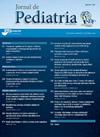使用母乳添加剂的极低出生体重儿体内锌和铜含量分析:第一阶段试验结果。
IF 2.8
4区 医学
Q1 PEDIATRICS
引用次数: 0
摘要
研究目的本研究旨在评估母乳添加剂提供的微量元素锌和铜是否足以满足极低出生体重早产儿的需要:对出生体重极低的早产儿进行了一期随机双盲对照试验。这是对铜和锌的二次分析。最初的样本中有 66 名新生儿,其中 40 名参与并进入了研究的最后阶段。纳入标准为:胎龄小于 37 周、出生体重大于或等于 750 克且小于或等于 1500 克、胎龄小或与胎龄相符、每天每公斤纯母乳喂养量大于或等于 100 毫升、血液动力学稳定。参与者被随机分配到两组:干预组 Lioneo(饮用添加了冻干人乳添加剂的人乳),n = 20;对照组 HMCA(饮用添加了牛乳蛋白商业添加剂的人乳),n = 20:结果:从研究的第一天到第二十二天,组内血清锌水平有所下降(p 结论:人乳添加剂不足以降低婴儿的锌和铜水平:母乳添加剂不足以维持极低出生体重新生儿血清中足够的锌水平。无法确定母乳添加剂是否足以维持研究样本中足够的血清铜水平。U1111-1220-0550.本文章由计算机程序翻译,如有差异,请以英文原文为准。
Analysis of zinc and copper levels in very low birth weight infants using human milk additives: phase 1 trial findings
Objective
The aim of this study was to assess whether the micronutrients zinc and copper, provided by human milk additives, are sufficient for very low birth weight preterm infants.
Method
A phase 1 randomized double-blind controlled trial was conducted with very low birth weight preterm infants. This is a secondary analysis of copper and zinc. Sixty-six newborns were part of the initial sample, with forty participating and reaching the final stage of the study. Inclusion criteria were: gestational age less than 37 weeks, birth weight greater than or equal to 750 g and less than or equal to 1500 g, small or appropriate for gestational age, exclusively receiving human milk at a volume greater than or equal to 100 mL per kilogram per day, and hemodynamically stable. Participants were randomly assigned to two groups: intervention, Lioneo (received human milk with additive based on lyophilized human milk), n = 20, and control, HMCA (received human milk with commercial additive based on cow's milk protein), n = 20, and their serum levels of zinc and copper were measured on the first and twenty-first days.
Results
There was a reduction in intragroup zinc serum levels from the first to the twenty-first day of the study (p < 0.01). There was no intergroup difference. No difference was found in serum copper levels.
Conclusion
Human milk additives were not sufficient to maintain adequate zinc serum levels in very low birth weight newborns. It was not possible to affirm whether human milk additives were sufficient to maintain adequate serum copper levels in the studied sample. UTN: U1111–1220–0550.
求助全文
通过发布文献求助,成功后即可免费获取论文全文。
去求助
来源期刊

Jornal de pediatria
医学-小儿科
CiteScore
5.60
自引率
3.00%
发文量
93
审稿时长
43 days
期刊介绍:
Jornal de Pediatria is a bimonthly publication of the Brazilian Society of Pediatrics (Sociedade Brasileira de Pediatria, SBP). It has been published without interruption since 1934. Jornal de Pediatria publishes original articles and review articles covering various areas in the field of pediatrics. By publishing relevant scientific contributions, Jornal de Pediatria aims at improving the standards of pediatrics and of the healthcare provided for children and adolescents in general, as well to foster debate about health.
 求助内容:
求助内容: 应助结果提醒方式:
应助结果提醒方式:


